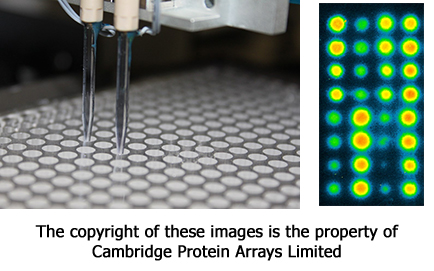Analytik reports on use of the GeSiM Nano-Plotter system to produce DNA and protein arrays for research at the Babraham Institute
 Analytik reports on use of the GeSiM Nano-Plotter system to produce DNA and protein arrays for research at the Babraham Institute
Analytik reports on use of the GeSiM Nano-Plotter system to produce DNA and protein arrays for research at the Babraham Institute
Cambridge, UK, 27th May, 2014: Analytik, leading suppliers of innovative analytical instrumentation, report on research work at the Babraham Institute to study protein microarrays using the GeSiM Nano-Plotter system.
Affinomics is an EC FP7 Collaborative Project set up to initiate the generation of a proteome-wide binder collection. To this end, the project integrates the expertise and technologies available in leading European centres in order to create an efficient pipeline for target and binder production, validation and quality control. It is coordinated by Dr Mike Taussig of the Protein Technology Group at the Babraham Institute near Cambridge. He is a co-inventor of the Ribosome Display technique as well as the PISA and DAPA methods for production of protein arrays. Dr Oda Stoevesandt and Dr Ronny Schmidt are post-doctoral scientists with experience in protein array technology and optimisation who work on both conventional protein arrays and the DAPA system.
Dr Stoevesandt describes their research work and how they came to choose the GeSiM non-contact sub-nanolitre dispensing system from Analytik for the production of various protein arrays. “We are interested in making and using protein microarrays. For making them, we have two options: The obvious one – spotting proteins. Then there is the special one – spotting arrays of protein coding DNA, and then using cell-free protein expression to create the corresponding protein array. The latter is a proprietary technology that we have developed; we call it DAPA – DNA array to protein array. We do all our spotting for either array technology with a GeSiM Nano-Plotter NP2.1. We apply the protein arrays mainly for specificity screening of antibodies, and for characterising the targets of autoantibodies in autoimmune sera. We do this both academically, as well as in our company Cambridge Protein Arrays Ltd. (www.cambridgeproteinarrays.com).”
Continuing, Dr Stoevesandt talks of the use of the Nano-Plotter. “We liked the complete control over the spotting layout that the GeSiM software allows, which is particularly important for our DAPA DNA template arrays. Being a non-contact printer, the Nano-Plotter also allows us to control the dispensed volume, at least in terms of multiples of the unit droplet. This is very handy for technology development to optimise the deposited amount of material for a particular application. We also liked the compact size and affordability of the GeSiM Nano-Plotter.”
To find out more about the GeSiM range of Nano-Plotter solutions, visit: http://www.analytik.co.uk/product/non-contact-nanolitre-dispensing-nano-plotter/
About…The Babraham Institute, which receives strategic funding (£23.1M from 2012-2013) from the Biotechnology and Biological Sciences Research Council (BBSRC), undertakes international quality life sciences research to generate new knowledge of biological mechanisms underpinning ageing, development and the maintenance of health. The Institute’s research provides greater understanding of the biological events that underlie the normal functions of cells and the implication of failure or abnormalities in these processes. Research focuses on signalling and genome regulation, particularly the interplay between the two and how epigenetic signals can influence important physiological adaptations during the lifespan of an organism. By determining how the body reacts to dietary and environmental stimuli and manages microbial and viral interactions, we aim to improve wellbeing and healthier ageing. (www.babraham.ac.uk)


